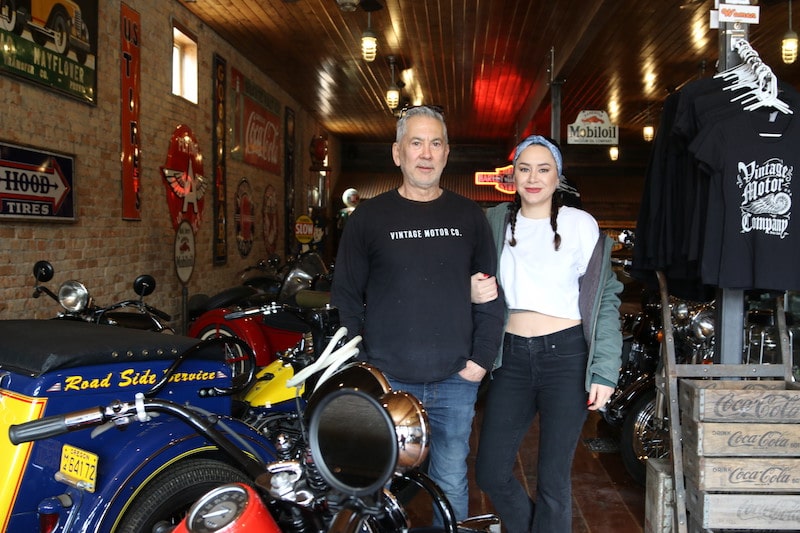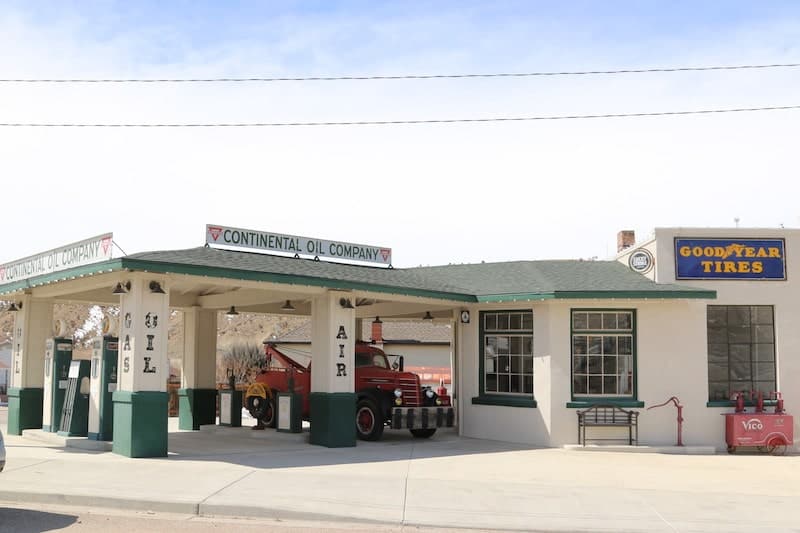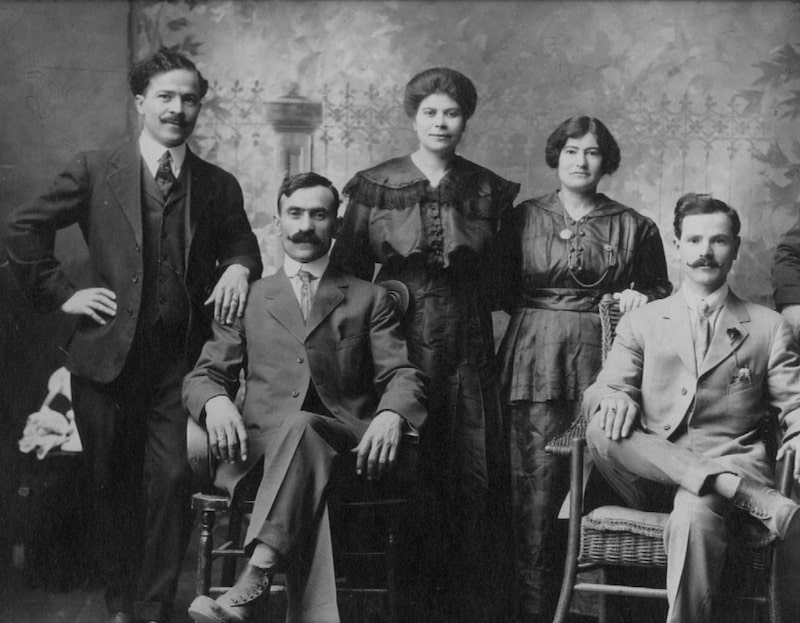
Helper’s Main Street is now one of the most vibrant, visited and flourishing main streets in Utah, but how did they manage to restore facades and dilapidated old buildings on a shoestring?
Malarie and Gary DeVincent have been renovating and restoring Helper’s old buildings and homes for the past eight years. Their crowning achievements are the Lincoln Hotel and the Vintage Motor Company: a museum featuring Gary DeVincent’s huge collection of rare Harley Davidson and Indian motorcycles.
DeVincent describes how he transitioned from living in Salt Lake City. For nearly forty years he was restoring vintage motorcycles before deciding to transition his knowledge into refurbishing historic houses and buildings as well.
Six years ago, DeVincent was attracted to Helper, along with his brother Bobby, as a place where he could store and display his Harley collection. His first project was to renovate an old building into a Harley Davison museum, but he also decided to acquire more buildings and homes around town to help bring more of Helper’s Main Street back to life.
For context, it’s worth knowing a bit of Helper’s history.
Helper, Utah was a former bustling coal mining and railroad town with a rich history dating back to the early Twentieth Century, as it was one of Utah’s most populated regions back then, attracting thousands of exiled young Greeks who fled their homeland due to Turkish-Ottoman rule and decay at the turn-of-the-century.
Helper’s mid-century history harkens back to the days when Hollywood actors like John Wayne, as well as prominent Utah political leaders would go on “hunting trips.” The “hunting” usually involved patronizing and cavorting at one of the town’s 15 brothels.
Helper’s flourishing sex trade was protected by then prominent businessman Matt Starr. The brothel industry in Helper was patronized even by former Governor Calvin Rampton and many prominent Salt Lake City judges. The illegal trade was granted immunity from the law due to Starr, who ensured that both the ladies and customers were behaving. The brothel era lasted for nearly half-a-century.
The decline of the brothel business coincided with Carbon and Emery Counties’ declining coal industry. Workers migrated to greener pastures, and homes and buildings were shuttered and abandoned. According to Tino Gutierrez, owner of the Regis Club on Main Street, “Helper didn’t die when the coal mines closed; it died when the last brothel closed in 1976.”
In 2022, despite County Commissioners spending money on “A rally for coal”, 17% of all coal miners in Carbon County lost their jobs, further exacerbating the decline of the industry that sustained families for decades. Since that period, Carbon County has suffered from the use and abuse of oxycodone as well as amphetamines and heroin.
But, as the “old-timers” have told Utah Stories in the past, “We aren’t Moab — we don’t want to be Moab!”

“Now the County is fully on board with tourism,” says Cindi Edwards Curry, who operates four businesses in Helper. She says that when she attempted to push tourism just five years ago, she received a lot of backlash, but today the County agrees that the future of Carbon County might not be what is buried in the hills, but the hills themselves. “Money in the economy is beneficial whether it comes from tourism or coal,” she says.
In 2012, Utah Stories first reported on Helper when some well renowned Utah artists were acquiring the buildings on Main Street for their art galleries and studios and permanently relocating to the town to focus on their craft.
Artists such as Ben Steele and David Dornan, Kathleen Royster, Jannine Hogan, and at least a dozen others have slowly shaped the small town’s Main Street into an artists’ enclave. They love the fact that their cheap mortgages enable them to focus on producing and fine-tuning their skills full-time rather than compromising their artistic vision and values to make ends meet.
But today a new wave of residents are moving into Helper who are enticed by the AirBNB business model. Just five years ago, a large number of the town’s homes and buildings were still abandoned and dilapidated, but thanks to sweat equity, a new breed of renovators and entrepreneurs are adding to the town. The former abandoned homes, once unfit for human habitation, are getting a second life.

Nightly Rentals Dominating Economy?
Nightly rentals have plagued Moab’s tourism-based economy by diminishing the housing supply. Old-timers have a valid reason to be afraid that their success could end up pricing locals out of the market. Carbon County once offered the most affordable housing in the state of Utah, but now, every dilapidated home has become an investment opportunity.
Gary elaborates, “The money people got wind of it … homes that were just $50,000 five years ago are going for over $300-$400 thousand.” Malarie says that a fixer-upper can still be bought for under $180K, which is still a bargain by Salt Lake City and neighboring Moab standards.
Still, the equity that DeVincent is adding to not only the nightly rentals, but also to the street’s historic character, is unquestionable. The street is slowly transforming from a shuttered nearly ghost town into a vibrant living museum highlighting a bygone era.
According to the DeVincents, “Helper has become a viable alternative to increasingly expensive Moab housing. There are so many people from Moab who are moving here. They are fleeing here.”
DeVincent believes that the town’s heart for renovation and preservation will remain intact as long as new residents are aware that keeping the old along with the new is the priority. A big part of what’s new is the incredible growth of Helper Saturday Vibes.
Now in its third season, Helper Saturday Vibes was initiated two years ago in 2021 through a partnership between Kimberly Kuehn and Helper City. Kuehn successfully launched the Park Silly Sunday Market in Park City over a decade ago, Kuehn says, “I was told by some friends that I needed to see Helper, I was supposed to stay for four days, and I never left.” Kuehn applied her event organizing skills, in collaboration with 2021 Helper newcomer and now Market Manager Allie Farnham, in building something similar to a Street Festival in Helper. Now their team of over thirty Carbon County locals are attracting dozens of vendors who sell their wares; food trucks, non-profits, and an impressive sound stage located in Helper’s Historic Main Street Park that hosts some of Utah’s top music talent. They even boast a full bar featuring what are rumored to be Carbon Counties best top-shelf margaritas! “Every year since we started we have doubled attendance and doubled our total number of vendors,” says Farnham.
How Do You Keep Helper’s Economy Strong and Year-Round?
During the weekend, I visited Helper and discovered that the DeVincent’s nightly rentals were completely booked for the first time this year. They believe this is going to be a huge year for the tiny town. DeVincint says this is thanks to the artist community and the incredible talent that has been attracted to the town.
With rates for Moab hotels in April and May going for an average of around $250 per night, Helper’s charm, nature trails and a new brewery are making the town an affordable alternative to Moab during the busy season.
The Growing Pains of Progress
The DeVincents said that they had to “fight the County” for six months to get their approval to renovate two old homes rather than tear them down, which would have been simpler.
Everyone Utah Stories spoke to in Helper appreciates what the DeVincents are doing.
Edwards-Curry says, “Gary and Bobby work so incredibly hard and they really do put their heart and soul into everything they do. They are making the town a much better place.”

